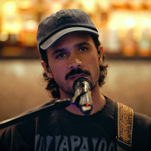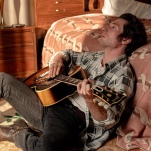Emmy-Winning Composer Mac Quayle on the Music of Mr. Robot and Ryan Murphy’s Many TV Universes
Photo: Michael Parmelee/USA Network
Mac Quayle’s score for Mr. Robot might be described as futuristic, if creator Sam Esmail’s suspenseful drama, nearing the end of its third season, weren’t so firmly situated in the recent past: In the context of USA’s high-tech, anti-capitalist thriller, its foreboding electronic hum suggests revolutions (and counterrevolutions) still on our horizon.
Now, Quayle is bringing the music of Mr. Robot to Los Angeles’ Roxy Theatre, where he’ll perform his score for a live audience Tuesday, Dec. 5. (Tickets to “M@cQuayle_TheMus1c0fMrRob0t.mp3,” which mimics the series’ distinctive episode titles, are available here.) Paste reached Quayle by phone to discuss the genesis of the Roxy performance, the evolution of Mr. Robot’s sound, and his work for the ultra-prolific Ryan Murphy. The one topic that was off limits was his score for the second season of American Crime Story, The Assassination of Gianni Versace, which premieres in January on FX: “I can essentially only say things that have already been out there,” Quayle says, laughing.
The following has been lightly edited for length and clarity.
Paste: How did the idea for the show at the Roxy come about, and what can you reveal about what it’s going to look and sound like?
Mac Quayle: The idea, in general, to perform any of my scores live has been kicking around, at least in my mind, for quite some time. The first real opportunity that I had was to perform at a film musical festival in Málaga, Spain called the MOSMA Festival. Once that was booked, I started putting together the show, trying to come up with exactly how it would work and who would play and what we would play. In preparation for that, we did a preview set in Los Angeles like a month before, then we went and did this full set of Mr. Robot music in Spain in July. This Roxy show is the next evolution of that idea that started there. The band, at the moment, is my self on keyboards, a second keyboard player, and a drummer. In Spain, we had a guitarist on two pieces of music, and I think the Roxy show will be similar. Maybe the guitarist will play on three or four pieces. It’s not out of the question that there might be another guest as well. The music of Mr. Robot, to me, lends itself to doing a concert that is a little outside of what I perceive as a normal film or television music concert. It’s not an orchestra. It’s best played in a venue that has a really nice sound system, so it can be really loud. It’s more akin to a rock or EDM show. That’s been my vision for it.
Paste: Speaking of the particular sound of Mr. Robot, how did you, in collaboration with Sam Esmail, conceptualize it?
Quayle: Our very first meeting, the idea was that it would be a fully electronic score, that it would have an electronic sound. There would be a slight retro element to it, but it wouldn’t be a fully retro-sounding electronic score. That’s a fairly broad parameter, but that’s what we started with. The other important buzzwords were the feeling that the score would help to produce. Paranoia. Tension. Anxiety. Pretty dark. That was the starting off point… We’re now in Season Three, and that has expanded somewhat. It’s still the core of what we’re doing, but we’ve added more organic instruments, and the sound has kind of gone off in some other places that it wasn’t right in the beginning. I think that sort of mirrors how the story as well has spiraled into some new territory.
Paste: Can you talk about what inspired those departures or evolutions? “Eps3.5_kill-pr0cess.par2; it begins with a flashback to Angela as a child, and she’s talking to her mom. And there’s this kind of almost optimistic, rising sound, which bleeds kind of naturally into the sounds going off in the ECorp building.
Quayle: Sam had a lot of specific ideas about this scene, which I thought was a fantastic scene. It just had so much in it—great writing, this wonderful reference to Back to the Future, which Sam loves to put in. And we get to learn about this back story we’ve sort of been hinted at up until now. We get to see Angela’s mom and all of this. Sam had this really particular idea about how, once Angela’s mom is talking to her, this music is going to build and be uplifting and yet be a little bit surreal. It was a challenging scene to get right for me. We did multiple, multiple versions. And my first version wasn’t bad—it built, and it had good emotion, but it wasn’t hitting what Sam thought was the best way to tell the story. And so they kept asking me to go back and change it. What’s really good about this collaboration is that, more times than not, the notes they give me, it makes the music better. Each version it was getting a little stronger and a little clearer until finally—I think it was version seven or something—we had the tone that really seemed to give it that right feeling of optimism without being too happy, the right build, and then the right handoff into the present-day scene with the alarms.
Paste: Whether it’s pre-existing music that’s being integrated into the sound, or the fact the show has a ton of diegetic ambient noise, how do you make a show that has so much sound mesh with what you’re composing?
Quayle: A lot of it happens a little bit by accident. There’s some sound design in the cut that I’m working to, and it’s certainly influencing me somewhat, if not consciously then subconsciously. It may not be the final sound design, and the sound designer, Kevin, he’s working on all the final elements. When it all comes together on the mixing stage, they will make some adjustments to levels in the music, or maybe change the pitch of some of the sound effects and have it become a little more cohesive and make it fit together. Occasionally, Kevin and I will collaborate before that stage. There was a scene in “eps3.3metadata.par2” where Darlene [played by Carly Chaikin] talks to the pickpocket. Kevin had these sounds of the train tracks—he called them “train click-clacks, and it’s like the sound of the wheels of the subway going over the joints in the tracks—and they have a rhythm to them. So, he gave me his track, and I found this section that was pretty close in time, and I looped it, and then I used that as the tempo for my piece, and so everything was right in time with the train click-clacks. Every so often I would push the train track out of time just a little so it wouldn’t sound too perfect. There’s this meshing of the music there. We’ve done a couple other things with clocks this season, too—there’s a ticking clock, and the music is right in time with it. That kind of thing has been fun. Sam’s been very into the clocks this season, which also ties into the Back to the Future references and time as a theme.
Paste: I’d be remiss if I didn’t ask you a couple questions about your work with Ryan Murphy. What’s your approach to moving in between not just musical genres, but film and television genres in American Horror Story, American Crime Story and Feud, while retaining a sound that’s distinctively your own?
Quayle: In the shows that are contemporary—Horror Story, Crime Story, Mr. Robot—I really try to not use any of the same sounds from show to show. So each show has its own sound palette that would be unique. That’s the starting point for it having its sound be different from the others. And I’m always on the lookout. When I’m writing something, I sit back and listen—if I’m working on Mr. Robot, I’ll say, “Whoa, that sounds a little bit like Horror Story. I need to take a different approach, or vice versa.” Those are my rules, and then the shows themselves, they are quite different, so they will pull me in different directions. With Feud, I wasn’t really concerned that would sound like any of the shows I;’d done before, with a period 1960s orchestral score, and so that took on its own life outside of anything I’d done previously. How any of those I try to make sound like my own, that’s maybe better for someone other than me to say. It’s hard for me, at least, to be an observer of my own style. I’m just cranking it out and hoping that it does its job in helping to tell the story and that I’ve hit some of those points that I’ve just listed.
Paste: What are you looking at or listening to, if anything, when you’re in the brainstorming process?
Quayle: Mr. Robot’s sort of its own thing because it started off with a concept and we’ve stuck with that and expanded it a little bit. The Ryan Murphy shows, he has this fondness for every season being a whole new show, and so we’re always starting over… So there’s this initial period of coming up with ideas for what it’s going to sound like. Some conversations happen, looking at the period or the subject matter or the feeling that is wanted, and out of those conversations, often a playlist of existing music is generated, that perhaps some it evokes what will be the sound of the show. And then we start. For instance, Season Five, Hotel, of American Horror Story, we decided to go really electronic. And they were gonna use source music—all this great, interesting 1980s and 1990s stuff, like Joy Division and all these other cool pieces of music. And then I start writing, based on everything that’s happened: the conversations, the playlist, the first episode. And then they start responding to it, and out of that, the sound develops. Hopefully, by the time we’re done with the first episode, we’ve pretty much defined it.
Mr. Robot airs Wednesdays at 10 p.m. on USA. Read Paste’s episodic reviews here.
Matt Brennan is the TV editor of Paste Magazine. He tweets about what he’s watching @thefilmgoer.







































